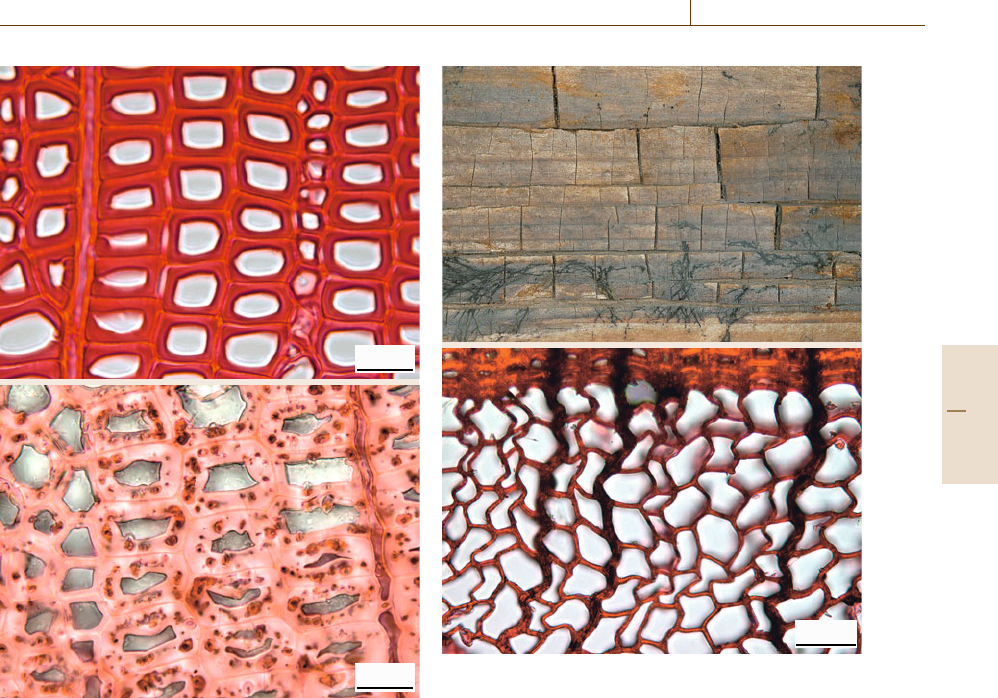Czichos H., Saito T., Smith L.E. (Eds.) Handbook of Metrology and Testing
Подождите немного. Документ загружается.


768 Part D Materials Performance Testing
Systems using Electrical Resistance Measurements
(ASTM International, West Conshohocken 2005)
13.23 I. Buresch, P. Rehbein, D. Klaffke: Possibilities of
fretting corrosion model testing for contact sur-
faces of automotive connector, Proc. 2nd World
Tribol.Congr.,ed.byF.Franek,W.J.Bartz,A.Pau-
schitz (The Austrian Tribology Society ÖTG, Vienna
2001)
13.24 D. Klaffke, M. Hartelt: Influence of electrical volt-
ages on friction and wear in water lubricated
sliding of SiC/SiC-TiC, Proc. 2nd World Tribol. Congr.,
ed.byF.Franek,W.J.Bartz,A.Pauschitz(The
Austrian Tribology Society ÖTG, Vienna 2001)
13.25 S. Raadnui: Wear particle analysis – utilization of
quantitative computer image analysis: a review,
Tribol. Int. 38, 871–878 (2005)
Part D 13

769
Biogenic Imp
14. Biogenic Impact on Materials
Materialsasconstituentsofproductsorcom-
ponents of technical systems rarely exist in
isolation and many must cope with exposure
in the natural world. This chapter describes meth-
ods that simulate how a material is influenced
through contact with living systems such as mi-
croorganisms and arthropods. Both unwanted
and desirable interactions are considered. This
biogenic impact on materials is intimately as-
sociated with the environment to which the
material is exposed (Materials-Environment In-
teraction, Chap. 15). Factors such as moisture,
temperature and availability of food sources all
have a significant influence on biological sys-
tems. Corrosion (Chap. 12) and wear (Chap. 13)can
also be induced or enhanced in the presence of
microorganisms. Section 14.1 introduces the cat-
egories between desired (biodegradation) and
undesired (biodeterioration) biological effects on
materials. It also introduces the role of biocides
for the protection of materials. Section 14.2 de-
scribes the testing of wood as a building material
especially against microorganisms and insects.
Section 14.3 characterizes the test methodolo-
gies for two other groups of organic materials,
namely polymers (Sect. 14.3.1) and paper and tex-
tiles (Sect. 14.3.2). Section 14.4 deals with the
susceptibility of inorganic materials such as
metals (Sect. 14.4.1), concrete (Sect. 14.4.2) and
ceramics (Sect.14.4.3) to biogenic impact. Sec-
tion 14.5 treats the testing methodology concerned
with the performance of coatings and coating
materials. In many of these tests specific strains
of organisms are employed. It is vital that these
strains retain their ability to utilize/attack the
substrate from which they were isolated, even
when kept for many years in the laboratory.
Section 14.6 therefore considers the importance
of maintaining robust and representative test
14.1 Modes of Materials –
Organisms Interactions ......................... 770
14.1.1 Biodeterioration/Biocorrosion........ 770
14.1.2 Biodegradation............................ 771
14.1.3 Summary .................................... 771
14.1.4 Role of Biocides ........................... 771
14.2 Biological Testing of Wood .................... 774
14.2.1 Attack by Microorganisms.............. 776
14.2.2 Attack by Insects .......................... 781
14.3 Testing of Organic Materials .................. 789
14.3.1 Biodeterioration .......................... 789
14.3.2 Biodegradation............................ 791
14.3.3 Paper and Textiles........................ 803
14.4 Biological Testing of Inorganic Materials 811
14.4.1 Inorganic Materials Subject
to Biological Attack....................... 811
14.4.2 The Mechanisms of Biological
Attack on Inorganic Materials ........ 813
14.4.3 Organisms Acting
on Inorganic Materials .................. 814
14.4.4 Biogenic Impact on Rocks.............. 818
14.4.5 Biogenic Impact
on Metals, Glass, Pigments............ 823
14.4.6 Control and Prevention
of Biodeterioration....................... 824
14.5 Coatings and Coating Materials.............. 826
14.5.1 Susceptibility of Coated Surfaces
to Fungal and Algal Growth ........... 826
14.6 Reference Organisms ............................ 833
14.6.1 Chemical and Physiological
Characterization........................... 833
14.6.2 Genomic Characterization ............. 834
References ..................................................
838
organisms that are as capable of utilizing a sub-
strate as their counterparts in nature such that
realistic predictions of performance can be made.
Part D 14

770 Part D Materials Performance Testing
14.1 Modes of Materials – Organisms Interactions
A number of interactions result from the contact be-
tween living systems and materials some of which result
in either biodeterioration or biodegradation. The word
deteriorate comes directly from Latin and means to
make worse. The term biodeterioration was adopted
in the late 1950s to early 1960s for the study of the
deterioration of materials of economic importance by
organisms. However, this definition should probably be
expanded to include not only the deterioration of ma-
terials, but also of constructions (e.g. structual timber
as part of a building) or processes (e.g. a paper mill) of
economic importance.
Of course, the interaction between biological sys-
tems and materials is not always undesirable. In contrast
to the above, the word degrade also comes directly
from Latin and means to step down. Thus, biodegrada-
tion could mean activities of organisms which result in
the breakdown of materials either to man’s detriment
or benefit. Many essential geochemical cycles (e.g. the
nitrogen and carbon cycles) are almost wholly depen-
dent on biological (indeed microbiological) processes
and of course in current times the term biodegradable is
considered an essential property of many manufactured
materials to ensure that they can be recycled effectively
at the end of their service life. So, although biodegra-
dation may be seen by man as a direct opposite to
biodeterioration, it is actually biologically exactly the
same process and it is impossible to make a scientific
distinction between them. Indeed, they are usually the
same processes, changed in meaning and significance
solely by human need.
A subdivision of the manifold effects of a biogenic
impact on materials may either be made according to
materials or to organisms. Changes of materials or their
service properties may be caused by microorganisms,
higher plants as well as by insects and other animals.
Among the microorganisms bacteria, yeasts and algae
play an important role as do many molds and higher
fungi and basidiomycetes. The dominating animal
species that impact on materials are among the insects
with termites and members of the orders coleoptera and
lepidoptera having an especially great destructive po-
tential. But higher animals such as rats, mice and birds
also have a significant impact on the service life of many
materials. In the marine environment molluscs and crus-
taceans are usually considered the main deteriorating
organisms. Although studies on the interaction between
material and biological systems need to be holistic in
their approach whether this be to determine the degree
of protection required by a material in service or to ex-
amine the impact of a material on an ecosystem, they are
usually subdivided into specific areas to afford a more
manageable route to their execution.
Materials primarily of natural origin, such as timber,
pulp, paper, leather and textiles are particularly suscep-
tible to deterioration by biological systems. However,
many modern materials such as paints, adhesives, plas-
tics, plasters, lubricating materials and fuels, technical
liquids, waxes etc. can support microbial growth. Even
the properties of inorganic products, such as concrete,
glass, minerals and metals may suffer from biological
attack. There are also many examples which demon-
strate that not all breakdown of materials is undesirable
as particular microorganisms are used for beneficial
purposes, e.g., in extracting and processing raw ma-
terials such as alcoholic fermentation, antibiotics, flax
retting, leaching etc. and even in extracting certain
minerals in mining operations (e.g., bioextraction of
uranium from mining residues).
14.1.1 Biodeterioration/Biocorrosion
A natural phenomenon of organisms, especially of mi-
croorganisms, is adhesion to surfaces of materials. For
example, in the course of their proliferation a slimy
matrix is produced by microbial communities at the in-
terface with a material called a biofilm. In technical
systems biofouling occurs. Drinking or process waters
become contaminated, often by biofilms, and further
propagation of biomass results in blockages of filter sys-
tems, pipings and heat exchangers. Economic damage
results from the decrease in performance of technical
processes (such as loss of efficiency in a heat exchanger)
and can even result in equipment or facilities coming
to a complete standstill. Losses amounting to billions
of Euros every year are attributable to the effects of
unwanted biofilms.
Another prominent example of the impact of
biological systems on materials can be seen in the in-
teraction between the organisms employed in a process
with the materials used to contain it in the microbial
deterioration of concrete in sewage systems caused by
acidic fungal excretions. The same mechanism is also
responsible for the deterioration of historic frescos and
monuments. Even seemingly inert materials, such as the
glass in optical devices, for instance binoculars and mi-
croscopes, are susceptible to etching which impairs and
ultimately destroys their optical properties.
Part D 14.1

Biogenic Impact on Materials 14.1 Modes of Materials – Organisms Interactions 771
Biological processes may also produce discol-
oration and bad odors of liquids such as paints, glues,
lubricating and technical liquids without actually affect-
ing the performance of the material. Of course, they
may also induce changes in consistency and impair the
serviceability of such products or result in complete
failure of the material. With plastics, biodeterioration
can result in loss of mass and changes of technical char-
acteristics, such as elasticity and tensile strength.
Effects of biodeterioration produced by organisms
can range from damage caused by inorganic or organic
acids, complexation, organic solvents, salt stress, in-
fluence of H
2
S, NO
3
,andNO
2
as well as enzymatic
alterations or degradation. Biocorrosion of metals and
metal alloys is also know to occur under a wide variety
of conditions. The first reports on the corrosive proper-
ties of sulfate-reducing bacteria date back to the middle
of the past century. Corrosion failures in oil refiner-
ies, pipelines and harbor facilities induced intensive
research and investigations of the damage mechanisms.
Spectacular accidents, such as the crash of a jet airplane
due to corrosion of its aluminum fuel tanks illustrated
the dangers of microbially induced corrosion (MIC). In
most cases both bacteria and fungi were found to be
responsible for such damage. The corrosion processes
were induced either by their metabolites, such as acids,
ammonia and hydrogen sulfide or by electrochemical
circuits associated with the terminal electron acceptors
of anaerobic metabolism. The capability of these mi-
croorganisms to form adhesive films on the surface of
metals exacerbated the problem as below such films,
anaerobic conditions prevail where corrosion-inducing
oxygen concentration cells are produced. Similarly, hy-
drogen embrittlement may be also attributed to the
production of hydrogen by microorganisms and its up-
take by the metal surface.
14.1.2 Biodegradation
The manifold metabolic processes of organisms have
been utilized by man in the course of his evolu-
tion. Long before the term biotechnology was coined,
people knew how to produce foods by exploiting micro-
bial processes. Agricultural applications included flax
retting and waste straw upgrading. Important medi-
cal applications such as the production of antibiotics
emerged. For a number of microbiological metabolic
processes the following synonyms for biodegradation
became established; biotransformation/bioconversion,
implying the biological transformation of materials as
an alternative to chemical processes. Bioleaching: metal
extraction (especially of copper and uranium) from poor
ores and mining spoil, the extraction of which would
not be profitable by metallurgical processes. Biotreat-
ment, for example, kaolin for producing porcelain but
stained by iron oxides may be successfully bleached
by reducing or complex-forming metabolites of mi-
croorganisms. Bioremediation, for example, TNT and
a number of other explosives may be reduced to harm-
less substances and microbial processes are being used
increasingly to decontaminate toxic substances in the
environment.
14.1.3 Summary
As discussed above, biodeterioration can be defined as
a decrease in the economic value of materials caused
by biological organisms. From a physical point of view,
biodeterioration can be defined as the transition of
a material from a higher to a lower energy level or
(chemically) from a more to a less complex state. From
a biological point of view it is important to be able
to relate biodeterioration and biodegradation events to
the cycle of changes of materials which characterize
the natural world. Thus, a material may be required to
be stable towards biological attack while in service but
needs to degrade in the environment to substances that
are harmless to and totally integrated with the environ-
ment once the service cycle has ended. Many materials,
constructions and processes must therefore be looked
at in a true cradle to grave context to ensure that the
economic benefits at one point do not lead to adverse
environmental (and economic) impact at a later stage in
the cycle of that material’s lifespan.
14.1.4 Role of Biocides
Many methods exist worldwide for examining the
relationship between organisms and both man-made
and natural materials. Much of the emphasis of these
methods is related to the spoilage, deterioration or de-
facement of materials whether these are foodstuffs,
structural woodwork or water-based coatings [14.1].
Most of the testing technology is focussed on deter-
mining both the susceptibility of materials to attack and
to the efficacy of agents intended to either prevent or
limit this attack. In many cases, these tests are used
to form the basis of claims about how well a certain
material, additive or technology may be expected to per-
form when exposed to biological challenges. Often this
information is used to make commercial comparisons
between either different final products or additives as
Part D 14.1

772 Part D Materials Performance Testing
well as to attempt to predict whether a material will
comply with a certain specification (e.g. service life).
Biocides
Much of the technology mentioned above depends on
the use of biocidal agents to prevent growth in as-
sociation with the material to be protected. In other
disciplines, such agents are employed to either limit the
growth of or kill organisms within a process, possibly
to prevent them from impacting on materials they may
come in contact with. A good example of such agents is
the additives employed in the water treatment industry.
These agents are used in applications such as cooling
and humidification systems and paper mills [14.1]. They
are introduced to both eliminate health risks associ-
ated with the uncontrolled growth of microorganisms
(e.g., prevention of the growth of Legionella spp. in
calorifiers) and limit the impact that they may have on
structural components within the process (e.g. corro-
sion, loss of heat transfer efficiency) and the products
of the process (e.g. foul odor in air handling systems,
defects in paper resulting from bacterial slimes).
Biocides are also employed to remove popula-
tions from either within the matrix of a material or
on the surfaces of a material. These agents are of-
ten applied as washes or rinses and are used to either
sterilize/disinfect or at least reduce either part or all of
any population that may be present [14.2]. Such disin-
fection processes can also take the form of an addition
of an biocidal agent to a matrix which contains a pop-
ulation (e.g., the reduction of microbial contamination
in metal working lubricoolants, the treatment of tim-
ber infected with eggs/larvae of wood-boring beetles).
Often this will be combined with the introduction of
protection against further growth [14.3].
Biocidal agents may also be incorporated into a ma-
terial to protect it in service. For example, preservatives
are used in coating systems to protect the material from
spoilage while in its wet state (so-called in-can protec-
tion) as well as to exhibit a biocidal effect in the finished
film, preventing mold and/or algal growth on the sur-
face of the coating once applied. Similarly, plasticized
polyvinyl chloride (PVC) may be formulated with the
addition of a fungicide to protect it from attack by mi-
crofungi and so protect the plasticizer and prevent loss
of elasticity in service [14.4]. Wood may be impreg-
nated with fungicides and insecticides prior to sale for
structural applications.
In most of the situations described above, the
treatment of a material is intended to either prevent
deterioration of it, maximize the protection of the ma-
terial or remove a population from a system prior to
its use. The biocides employed for such purposes and
the approaches taken to achieve effective disinfection
and preservation have been reviewed extensively else-
where [14.1, 5]. However, in recent years a new form
of interaction between a formulated material and bio-
logical populations has emerged. In part, this can be
viewed as either an extension of the degree of protec-
tion provided to a material by the inclusion of a biocidal
agent into it or as the transfer of the properties of exter-
nal treatments of a material into the material itself. The
inclusion of the biocidal agent is not simply to protect
the material from deterioration but to exert a biological
effect either to the immediate surroundings of that ma-
terial or to items that come into contact with it. These
effects may range from the prevention of growth of un-
desirable microbial populations on a material to which
they pose no physical, chemical or biological threat, the
immediate destruction of individual microbial cells as
they come into close association with a surface (possi-
bly without even coming into direct physical contact)
or to the inclusion of insecticidal agents into netting in-
tended as a barrier to mosquitos [14.6]. In all cases the
effect is external to the material from which the article
is constructed and is not merely present to protect either
the material or the item itself. However, it is possible
that the effect may take place within an item constructed
from a modified/treated material. For example, one can
imagine an air filter constructed of paper into which
antimicrobial properties have been introduced which is
intended to kill bacteria pathogenic to man which im-
pact on it [14.7]. Similarly, a polyethylene foam sponge
may be impregnated with an antimicrobial agent which
is intended to prevent the growth of bacteria associated
with food poisoning in man. This sponge may not be
intended to disinfect surfaces on which it is used but
simply to prevent it from becoming a reservoir of such
bacteria in a food preparation environment.
Clearly, there are some complex situations when the
effects intended by treated articles/treated materials are
to be considered and this will impact on the suitabil-
ity of the methods used to measure them. In general
however, the effect of a treated item/treated material
can be considered to be external to it. The effect is not
concerned with either preservation or protection of the
material/item itself and is not achieved by the applica-
tion of a disinfecting agent after the material has entered
service.
Finally, when considering suitable test methodolo-
gies, the scale and duration of the effect may need
to be considered with respect to the claim made. For
Part D 14.1

Biogenic Impact on Materials 14.1 Modes of Materials – Organisms Interactions 773
example, will the material/item be able to exert the
effect claimed for the effect to have any realistic ben-
efit? Similarly, will the scale of the effect be sufficient
to provide the benefit either claimed or implied? It is
unlikely that data to support such claims would be avail-
able from a single test and it is likely that ageing and
weathering studies would be needed in addition to tests
which provide basic proof of principle and demonstrate
performance under conditions which simulate actual
use.
Biocidal Activity
Biocidal activity is a generic term but in the context
of this chapter we are essentially considering microbio-
cidal, insecticidal, acaricidal and mulluscicidal activity
and is considered in more detail in [14.5]. In actual use
this activity is further subdivided to represent activity
against one or more groups within the various classes.
For example, in the case of microorganisms, this will
be impacted on by the microbial types/species which
are employed in testing and, to a certain extent, the type
of test required and this is considered in detail in other
chapters in this section. The scale of the effect will of-
ten be important in some applications but the outcome
of biocidal activity will result in a reduction in the num-
ber of test microorganisms as a result of an interaction
with the material through an irreversible, killing effect.
Such effects may be described as
1. Bactericidal: the effect is limited to a reduction in
the size of a vegetative bacterial population.
2. Fungicidal: the effect is limited to fungi. This ef-
fect may be attributed to activity against vegetative
growth, spores/dormant structures or both and may
require clarification depending on the intended use
of the product.
3. Sporicidal: the effect is against the spores/dormant
structures of bacteria.
4. Virucidal: the effect is limited to virus particles.
5. Protisticidal: the effect is exhibited against protozoa
and their dormant stages.
6. Algicidal: the effect is exhibited against algae and
their dormant stages.
Biostatic Activity/Repellency
In many of the cases of the protection/preservation of
materials the effects required are not associated with
killing a population but of either preventing its growth
or preventing it coming into contact with the material.
In this context most interactions between a biocide and
microbial populations are biostatic ones. As with bio-
cidal activity, this will be impacted on by the species
which are employed in testing and, to a certain extent,
the type of test required but obviously, the prevention
of growth/metabolism/colonization of/by the target
species should be demonstrated. It may be sufficient
to demonstrate that growth is either slower or reaches
a lower level than on an equivalent control material
to either substantiate a claim or demonstrate a bene-
fit. In many cases chemical microbicides exhibit both
biostatic and biocidal activity with the initial impact
on a microbial population being biostatic and sustained
contact resulting in biocidal action. Similar relation-
ships are found with molluscicides where presence of
a toxic agent is sufficient to deter attack. In some cases
limits to the efficacy of biostatic and repellency ac-
tion are not related to the potency of the agent but to
the durability of the effect in combination with a ma-
terial (e.g., leach resistance of a fungicide preventing
the germination of fungal spores that have alighted on
a coating applied to the facade of a building). As with
biocidal activity an equivalent subdivision of the type of
activity exists, e.g.
1. Bacteriostatic: the effect is limited to the preven-
tion of growth/metabolism of bacteria and possibly
the germination of bacterial endospores and other
dormant structures.
2. Fungistatic: the effect is limited to the prevention
of growth of fungi and possibly the germination of
fungal spores and other dormant structures.
3. Algistatic: the effect is limited to the prevention of
growth of algae and possibly the germination of dor-
mant structures.
Summary
Although the intrinsic activity of biocidal agents is im-
portant, of more concern is the interaction between them
and the material/system which they are designed to
protect. The spectrum of activity must be appropriate
to the challenge the materials is likely to endure and
the biocide must be compatible with the material as
well as be able to provide protection for a suitable pe-
riod of service. Although many of the tests described
in this section are designed to examine the suscepti-
bility of materials to biological attack, many can be
adapted to examine the impact a biocidal treatment can
have on that attack. With careful consideration, reliable
prediction of the performance of a material equipped
with a biocide can be made and this is often the main
challenge when considering the negative interaction of
biological systems with materials.
Part D 14.1

774 Part D Materials Performance Testing
14.2 Biological Testing of Wood
Section 14.2 deals with the degradation of wood, wood
products and wood treated with preservatives, by insects
and microorganisms. It introduces the test methodology
used to simulate such attack and how to estimate its im-
pact on the material. The approach to testing differs in
detail throughout the world. However, certain basic prin-
ciples are commonly accepted. The approach taken in
Europe will mainly be used to illustrate these principles.
Before elaborating on the specifics of attack by mi-
croorganisms (Sect. 14.2.1) and insects (Sect. 14.2.2)
some general aspects concerning the testing of wooden
materials will be considered.
Wood is one of the oldest construction materials. Its
natural availability and omnipresence had made it the
most obvious choice to build bridges, houses, ships etc.
for millenia. It is relatively easy to process, has good
insulating properties, has a high elasticity (compared
e.g. to concrete, steel, stone) and wood with a high den-
sity is amazingly fire resistant (e.g. oak, teak).
Wood can be cut and bent to the desired size and
shape. However, as a typical organic matter, its ba-
sic components and its constituents provide a nutrient
source for microorganisms, molluscs, insects and other
arthropods. Because of this, many species have de-
veloped natural defence systems. For example, some
tree species (e.g. bongossi, teak) often produce pheno-
lic substances which are deposited in the cells of the
heartwood. These substances can considerably delay the
attack by microorganisms and lend the material a de-
gree of natural durability. Laboratory and outdoor tests
have been developed to assess this natural durability for
the commercially most interesting wood species used
in Europe (see later: European Standard EN 350, Dura-
bility of wood and wood based products). In contrast,
other wood species (e.g. pine, beech) can be rapidly
degraded. To make long-term use of them in construc-
tion etc. they have to be preserved chemically with
a wood-protecting biocide. Therefore, the test standards
described in the following mainly deal with preservative-
treated wood/wooden materials to determine the effi-
cacy and performance of this material.
However, to determine the virulence of the microor-
ganisms used in the different test setups, untreated wood
is always incorporated. Some methods also employ so-
called reference products which include preservatives
that have shown their preserving effects on wood for
decades. With the help of a reference product the sever-
ity of a method can be estimated and the results for a new
preservative under test can be put into context.
Ideally, methods for determining the protective effi-
cacy and the performance of treated or untreated timber
should
•
Reflect the environmental conditions to which the
treated timber is subjected in service;
•
Cover all relevant organisms and their succession
during the time of use of the wooden commodity or
construction;
•
Take into account the possible methods of treatment
for the wood preservative;
•
Provide reproducible results rapidly;
•
Be uncomplicated and easy to handle;
•
Involve minimal costs.
Obstacles are
•
The environmental conditions and the decaying or-
ganisms to which the timber is subjected are ex-
tremely diverse,
•
The sensitivity of the decay organisms is different to-
wards different biocides,
•
The biocides applied are stressed not only by phys-
ical factors like evaporation, leaching and diffusion
but;
•
In the case of organic biocides, these compounds can
also be utilized by organisms that are not the target of
the chemical wood preservation and which may de-
teriorate the biocides or even use them as a nutrient
source;
•
Not all timber species are equally treatable.
Therefore it is necessary to simplify and to develop
methods which nevertheless give sufficient certainty for
the assessment of treated and untreated wood under test.
General Requirements
for Resistance Against Biological Attack
More general requirements for testing procedures are
outlined in the European Standard EN 350 for a natu-
ral resistance against wood-destructing organisms and in
EN 599 for a wood preservative derived resistance.
•
European Standard EN 350-1:
Durability of wood and wood-based products – Nat-
ural durability of solid wood – Part 1: Guide to
principles of testing and classification of the natural
durability.
•
European Standard EN 350-2:
Durability of wood and wood-based products – Nat-
ural durability of solid wood – Part 2: Guide to
Part D 14.2

Biogenic Impact on Materials 14.2 Biological Testing of Wood 775
natural durability and treatability of selected wood
species of importance in Europe.
•
European Standard EN 599-1:
Durability of wood and wood-based products – Per-
formance of wood preservative as determined by
biological tests – Part 1: Specification according to
use class.
•
European Standard EN 599-2:
Durability of wood and wood-based products –
Performance of wood preservative as determined
by biological tests – Part 2: Classification and
labelling.
The likelihood for a biological attack of wooden mater-
ials also strongly depends on the environment in which
the material is used. These potential environments can be
categorized into use classes, formerly known as hazard
classes, according to the European Standard EN 335.
•
European Standard EN 335-1:
Durability of wood and wood-based products – Def-
inition of use classes of biological attack – Part 1:
General.
•
European Standard EN 335-2:
Durability of wood and wood-based products – Def-
inition of use classes of biological attack – Part 2:
Application to solid wood.
•
European Standard EN 335-3:
Durability of wood and wood-based products – Def-
inition of use classes of biological attack – Part 3:
Application to wood-based panel.
EN 335-1 defines the environmental compartments in
which wood can be used and describes the main hazards
Table 14.1 European Standard EN 335 Durability of wood and wood based products – use classes: definitions, application to solid
wood and wood based panels
Use classes General use situation Description of expose
to wetting in service
Fungi Beetles
1
Termites Marine borers
1 Interior (dry) None – U L –
2 Interior, or under cover,
not exposed to the weather
(risk of condensation)
Occasionally U U L –
3 Exterior, above ground,
exposed to the weather
Frequently U U L –
4 Exterior in ground contact
and/or fresh water
Permanently U U L –
5 Permanently or regularly
submerged in salt water
Permanently U U L U
U = Universally present within Europe.
L = Locally present within Europe.
1
The risk of attack can be insignificant according to the specific service situation.
wood is exposed to. The standard defines five use classes
(Table 14.1). The European standard EN 335 is currently
under review. The aim of the review is to combine all
three parts to one comprehensive standard. Other coun-
tries developed similar classifications. An ISO standard
titled Durability of wood and wood based products –
Definition of use classes is basically following the same
principle.
Preconditioning Methods Before Durability
Testing of Treated and Untreated Wood
In order to evaluate the effectiveness of a wood preser-
vative over time, artificial ageing of protected wood is
performed before a standard test method against mi-
croorganisms or insects is carried out.
•
European Standard EN 73:
Accelerated ageing tests of treated wood prior to
biological testing – Evaporative ageing procedure
describes an evaporative ageing procedure, applica-
ble to test specimens of wood which have previously
been treated with a preservative, in order to evaluate
any loss in effectiveness when these test specimens
are subsequently subjected to biological tests, as
compared with test specimens which have not under-
gone any evaporative ageing procedure.
•
European Standard EN 84:
Accelerated ageing tests of treated wood prior to
biological testing – Leaching procedure describes
an ageing procedure by leaching, applicable to test
specimens of wood which have previously been
treated with a preservative, in order to evaluate any
loss in effectiveness when these test specimens are
subsequently subjected to biological tests, as com-
Part D 14.2

776 Part D Materials Performance Testing
pared with test specimens which have not undergone
any ageing procedure by leaching.
•
European Technical Report CEN/TR 15046 Wood
preservatives – Artificial weathering of treated wood
prior to biological testing – UV-radiation and water-
spraying procedure: This method describes an age-
ing procedure which simulates intervals of rain and
UV-radiation. Because it works with elevated tem-
peratures, to some extent also evaporation is in-
cluded with this method. The method combines the
main stresses by physical factors on the wood preser-
vative in treated wood specimens prior to fungal or
insect tests.
Modern organic fungicides and insecticides are sus-
ceptible to microbiological degradation. Therefore, the
above-mentioned ageing standards are not always suffi-
cient to determine the longevity of wood preservatives
formulated with these biocides. A European technical
Specification (CEN/TS 15397) titled Wood preserva-
tives – Method for natural preconditioning out of ground
contact of treated wood specimens prior to biological
laboratory tests exists. This method combines natu-
ral physical stress factors with the possible succession
of naturally occurring microorganisms. This technical
specification is intended to overcome the difficulties
caused by the nontarget microorganisms at least for
wood exposed to the general service situations defined
for European use class 3.
14.2.1 Attack by Microorganisms
Microorganisms can only attack wood when water is
present in its cell lumina. This state is described as wood
moisture above the fiber-saturation-point.Asaruleof
thumb this state is reached at about 30% wood mois-
ture content (related to the dry weight of the wood). Dry
wood cannot be metabolized by microorganisms and
needs no preservatives to protect it against them.
Above fiber saturation the main components of wood
– cellulose, hemicelluloses and lignin – can be degraded
by a vast number of microorganisms.
Wood-destroying fungi are the most evident and
powerful wood degraders. Their species belong to the
•
basidiomycetes, causing brown rot or white rot,
•
ascomycetes and fungi imperfecti, causing soft rot
and stains.
Wood-destroying bacteria can be present in ex-
tremely wet environments, but the speed at which they
degrade wood is normally very slow and they can be ne-
glected as metabolizing organisms of wood components.
Nevertheless, with wood preservation moving away
from inorganic, undegradable components towards or-
ganic compounds, the deterioration of these substances
might be influenced by bacteria, leading to a failure of
the wood preservative and therefore opening pathways
for wood-metabolizing organisms to attack.
In relation to wood destruction mass loss and there-
fore strength loss of the wood are the primary issues.
However, wood can also lose value through discol-
oration by microorganisms through molds and blue-
staining fungi that cause no loss of cellulose, hemicellu-
lose or lignin.
Detecting Wood-Destroying Fungi
by Visual Means
The above-mentioned types of rot cause different ap-
pearances of the attacked wood. In many cases this can
even be detected by the bare eye and can be confirmed
by microscopic work. For macroscopic evaluation the
wood should be dry, because checks and cracks become
more obvious this way. For cutting sections to be an-
alyzed microscopically the wood moisture should be
above the fiber saturation point (above 30% wood mois-
ture), because all strength properties of wood decrease
with increasing moisture content of the wood until the
fiber saturation point is reached. In other words: cutting
becomes easier.
Visual Distinction of the Main Types
of Wood Decay
Figures 14.2aand14.3a show brown rot and white rot on
wood macroscopically (here the wood has been cut lon-
gitudinally). Figure 14.1a shows undecayed, Figs. 14.2b
and 14.3b decayed cross sections of wood as it can be
seen under the microscope at a magnification of 150 ×
to 200 ×. Further macroscopic and microscopic exam-
ples of wood decay can be found in [14.8].
Soft Rot. These fungi degrade cellulose and hemicel-
luloses. Macroscopically they cause a greyish-black rot
with small cubicle cracks. Microscopically this form of
decay is characterized by cavity formation inside the cell
wall (Fig. 14.1b).
Blue Stains. Blue stains do not degrade lignin, cellulose
or hemicelluloses and therefore cause no loss in mass or
stability of the timber. They metabolize sugars deposited
in the parenchymatic tissue of the wood. Blue stain fungi
grow through the parenchymatic cells and spread in the
Part D 14.2

Biogenic Impact on Materials 14.2 Biological Testing of Wood 777
a)
b)
25µm
25µm
Fig. 14.1 (a) Cross section of sound undecayed wood (Picea
sp.). (b) Cross section of wood (Picea sp.) decayed by
soft rot causing cavity formation in the cell wall (Courtesy
of Swedish University of Agricultural Science, Uppsala,
Sweden)
wood. They stain the wood through their black-bluish
hyphae and spores.
Brown Rot Fungi. Brown rot fungi metabolize cellulose
and hemicellulose of the wood. Lignin can not be de-
graded by these fungi. The rot leaves behind cubic cracks
(Fig. 14.2a) and a dark brownish tinge to the wood. The
microscopic features are shown in Fig. 14.2b.
White Rot Fungi. White rot fungi metabolize all three
main components of wood: lignin, cellulose and hemi-
celluloses.
Macroscopically white rot fungi generally lighten
the color of the wood. Two types of white rot can be
distinguished: a) simultaneous rot, where in pockets
of decay the cellulose, hemicelluloses and lignin are
50µm
a)
b)
Fig. 14.2 (a) Longitudinal cut of wood (Picea sp.) decayed
by brown rot causing fungi; wood surface shows cubicle
cracks in wood decayed by brown rot, in the lower part of
the picture mycelium of the brown rot causing fungus can
be seen. (b) Cross section of wood (Picea sp.) decayed by
brown rot causing fungi (Courtesy of Swedish University of
Agricultural Science, Uppsala, Sweden)
completely degraded and b) the selective lignin degra-
dation. Whereas the pockets of decay can be easily
detected (Fig. 14.3a) the selective degradation of lignin,
which is the more common form of white rot, can not be
determined by changes of the wood surface like cracks or
holes. Mass loss and change to a lighter color of the wood
compared to the undecayed timber are the first signs of
such an attack. The microscopic features for lignin de-
graders are shown in Fig. 14.3b.
Lignin-degrading fungi can be detected by the pres-
ence of a phenolic oxidase enzyme based on the Ba-
vendam-test. This test allows to biochemically distin-
guish brown from white rot fungi.
Sap Stains. Fungi grow only on the surface of freshly
cut timber. They do not metabolize the wood itself, but
Part D 14.2
